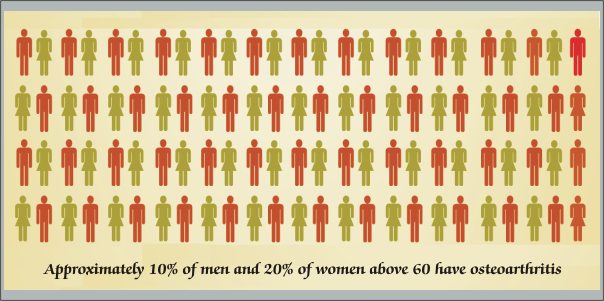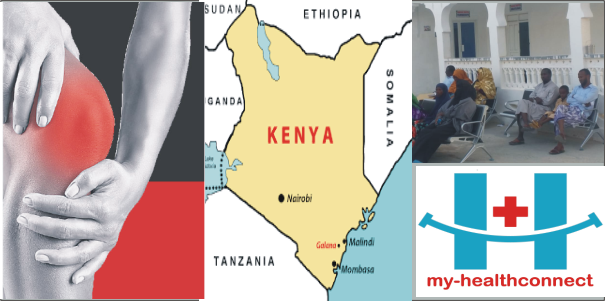Arthritis is a blanket term for about a hundred rheumatic diseases and conditions affecting the musculoskeletal system. Arthritis causes not only inflammation and damage to joints, with subsequent bone erosion, severe pain, and disability, but can also cause damage to other organs of the body, leading to increased mortality.
Stiffness, aching, grinding, swelling, outright pain—these are all symptoms of arthritis and can be a barrier to staying mobile as we age.
According to the World Health Organization (WHO), 9.6% of men and 18.0% of women aged over 60 years have symptomatic osteoarthritis worldwide. 80% of those with osteoarthritis have limitations in movement, and 25% cannot perform their major daily activities of life. OA is more common in women than in men. Nearly, 45% of women over the age of 65 years have symptoms while 70% of those over 65 years show radiological evidence of OA. (*)

What causes this trend? What makes women more susceptible to it? Are there any precautions preventive mechanisms that can be taken to stay away from this? Before moving further let us understand what is osteoarthritis?
What is Osteoarthritis?
Simply put osteoarthritis is the wear and tear of the cartilage that lines the end of your bones. Normally, cartilage is smooth, glistening, and white, and two cartilage-covered bones moving across one another in our joints are virtually frictionless. When the cartilage begins to wear down, though, like potholes in a road, the surface loses its smooth finish. This is when the stiffness and aching set in, causing pain.
Why is osteoarthritis more common in women than men?
Following are some of the reasons that may be causing osteoarthritis more in women:
Body Structure
A woman’s body structure plays a big role in her risk for osteoarthritis of the knees. Studies suggest that women with wider hips may be more prone to osteoarthritis as the particular body structure affects the alignment of the knee, causing uneven stress on them.
Pregnancy and Breast-Feeding
Pregnancy and breastfeeding cause changes and places extra demands on, women’s bodies. Some of these may affect their bones. Studies have shown that women often lose 3 to 5 percent of their bone mass during breastfeeding, caused by the growing baby’s need for additional calcium that’s drawn from the mother’s bones.
Hormones
Hormonal differences between men and women may play a role in the development of osteoarthritis. Postmenopausal women, in particular, have an increased risk of developing arthritis and this has been linked to the decrease in estrogen during this time.
Obesity
Osteoarthritis is closely linked to obesity. While men and women both suffer from obesity it is found that obesity in women is more common. Weight plays an important role in joint stress, so when people are very overweight, it puts stress on their joints, especially their weight-bearing joints, like the knees and the hips more weight that’s on a joint, the more stressed the joint becomes, and the more likely it will wear down and be damaged.
Need to Spread Awareness
It is obvious now that healthcare organizations need to maximize their role as an educator, innovator, and mediator of science. By educating women, spreading awareness and breaking gender stereotypes a lot of preventive action can be taken to fight arthritis. We would like to share our work in this area.
my-healthconnect’s Initiative in Nairobi, Against Arthritis
As a starting point to spread awareness against the various ailments that lead to knee and joint pain, my-healthconnect held a camp at Nairobi . Our objective was to spread awareness of arthritis as a disease, address the common pain points that lead to it and offer preventive medicine along with active treatment for affected patients. We were amazed and overwhelmed by the response that we received. We addressed the issues and concerns of people of all age groups. Amongst this, there was a large percentage of women who were facing issues such as knee and joint pains.
One such lady who walked to us was Rachael Wanjiku, a middle-aged lady in her mid-sixties. Rachael Wanjiku was suffering from acute joint pain. While she was prescribed medication, the dosage and drug were inadequate to handle her case of advanced arthritis. On diagnosing her we changed her prescription and put her on advanced drugs that steadily offered her relief. As arthritis had affected most of her joints we knew that sooner or later she would have to opt for surgery. We gave her the heads up and advised her to consult a doctor.
In about six months her son reached out to us again. It was endearing when he mentioned that he would like us to advise on the surgery. He wrote that our medication had worked on his mother more effectively than any other doctor they had been to so far and hence he entrusted us with the task of her surgery too. We have sent her x-rays to the concerned doctors and we are now working on the logistics of her treatment. In the meanwhile, we are sharing the kind words of appreciation written by Mr.Isaiah (son of Rachael Wanjiku).
Moving On
Being a medical platform we strive to serve the community by providing services around health education and access to care. If you’d like to join us in our endeavor or would like to know more about us do write to us today at info@myhealthconnect.com.
(*) Source: https://www.nhp.gov.in/disease/musculo-skeletal-bone-joints-/osteoarthritis



